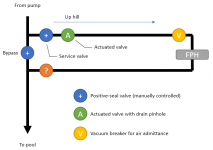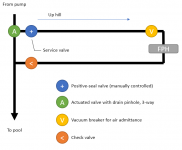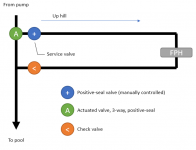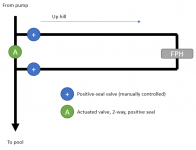As posted elsewhere, I'm planning to add an actuated heating loop and I have a pretty basic plumbing question. Assuming it looks like this:

Note that to the right is up an incline. The FPH is about 6' higher than the pad. The heating loop will be controlled by the green actuated valve. From reading about solar loops, I understand that the actuated valve should have a small hole in it to allow water to drain out of the loop when not in use, and a vacuum breaker should be included at the top. This means you also need a second positive-seal valve, plus a bypass valve, so the loop can be isolated for service.
Two questions then:
1. Does this all look good? Anything I'm missing?
2. What should go at the orange question mark, at the return side of the loop? I was thinking I could just put a check valve here. Are check valves considered positive-seal, enough that the loop can be fully isolated for service? Or do I need both a check valve and another service valve?

Note that to the right is up an incline. The FPH is about 6' higher than the pad. The heating loop will be controlled by the green actuated valve. From reading about solar loops, I understand that the actuated valve should have a small hole in it to allow water to drain out of the loop when not in use, and a vacuum breaker should be included at the top. This means you also need a second positive-seal valve, plus a bypass valve, so the loop can be isolated for service.
Two questions then:
1. Does this all look good? Anything I'm missing?
2. What should go at the orange question mark, at the return side of the loop? I was thinking I could just put a check valve here. Are check valves considered positive-seal, enough that the loop can be fully isolated for service? Or do I need both a check valve and another service valve?




